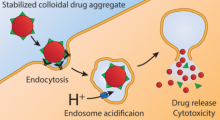BACKGROUND
The aggregation of small molecule drug candidates to form larger colloidal structures can render a promising drug ineffective. This limited efficacy is due to the inability of colloids to directly cross the plasma membrane due to large size (100 – 1000 nm). Furthermore, while strategies enabling uptake of colloids by cells exist, they are often still trapped within the endo-lysosomal pathway that isolates them from the main cell body. Despite this, the very high drug content of colloids (> 50%) renders them as ideal drug delivery systems if the propensity of their monomeric small molecule subunits to aggregate can be triggered towards dispersion, or drug release.
TECHNOLOGY
Researchers at the University of Toronto and UCSF show that the acidity of endo-lysosomal compartments can be used to trigger release of drugs from colloids into the rest of the cell, thereby increasing the cytotoxicity of these formulations (Figure 1). Colloids containing an active drug and a colloid stabilizer can enter cells through receptor-mediated endocytosis. The acidic nature of the endosomes trigger disruption of colloids through a pH dependent mechanism (protonation of colloidal small molecules) releasing the drug to exert its function.
Figure 1. Small molecules drugs can aggregate to form colloids above their CAC (left) reducing their efficacy. Delivery of pH-responsive colloids (right) can overcome this problem and deliver large drug payloads. Once endocytosed, the low pH in endosomes triggers drug ionization resulting in colloidal disruption and small molecule release.
COMPETITIVE ADVANTAGE
- pH triggered release of drug increases drug efficacy (see Figure 2)
- Enables delivery of high concentrations (loadings greater than 75%) of drug to cells
- Can exploit pH properties already present in approved drugs and excipients without chemical modification (e.g. Lapatinib, Clotrimazole, Nilotinib, Pazopanib)
APPLICATIONS
- Drug delivery
INTELLECTUAL PROPERTY STATUS
- PCT application filed (June 2020)
PROJECT STATUS
Proof of concept studies have been conducted with colloids composed of a pH responsive (lapatinib, pKa ~ 7.2) and unresponsive (fulvestrant, pKa ~ -0.88) drug in a breast cancer cell line (MDA-MB-231-H2N) (Figure 2). Enhanced cytotoxicity was observed upon using pH-responsive colloids and transferrin.
Figure 2. pH responsive colloids are cytotoxic after endocytosis and subsequent endosome disruption. Lapatinib/fulvestrant (pH responsive) colloids were more cytotoxic than colloids containing non-pH-responsive drugs (fulvestrant) or no drugs. Transferrin-containing colloids were more cytotoxic due to increased endocytosis.





